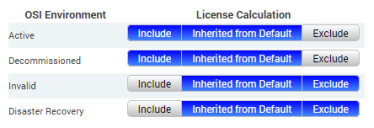Software Library page: OSI Environment Policy tab
The OSI Environment Policy tab on the Detail panel on the Software Library page enables you to specify OSI Environment Policy settings and Software Lifecycle Stages for the item selected in the Selection pane at the top of the Software Library page.
The OSI Environment Policy tab has two sections:
OSI Environment Policy section
The OSI Environment Policy section lists all OSI environment policies that have been created in License Optimizer and enables you to specify how to calculate licensing for the selected item when it has been identified on an OSI allocated to any one of the OSI environment policies in the system.
Example
In the screenshot shown below, the item settings have not been amended and the settings are all inherited from the default, indicated by the Inherited from Default button being highlighted in blue. You can also see that the default for the Active OSI Environment Policy is Include, as this button is highlighted in blue along with the Inherited from Default button.
The above settings result in the following outcomes in reconciliation:
- If the software is identified on an OSI allocated to the Active OSI environment, the software is included in the reconciliation.
- If the software is identified on an OSI allocated to the Decommissioned OSI environment, the software is included in the reconciliation.
- If the software is identified on an OSI allocated to the Invalid OSI environment, the software is excluded from the reconciliation.
- If the software is identified on an OSI allocated to the Disaster Recovery OSI environment, the software is excluded from the reconciliation.
To edit the settings for the selected item, click Include or Exclude to change the settings for each OSI environment policy. In the screenshot below, the Decommissioned and Disaster Recovery OSI Environment settings have been set to Exclude, and the Invalid OSI Environment setting has been set to Include:
The above settings result in the following outcomes in reconciliation:
- If the software is identified on an OSI allocated to the Active OSI environment, the software is included in the reconciliation (inherited from the default).
- If the software is identified on an OSI allocated to the Decommissioned OSI environment, the software is excluded from the reconciliation.
- If the software is identified on an OSI allocated to the Invalid OSI environment, the software is included in the reconciliation.
- If the software is identified on an OSI allocated to the Disaster Recovery OSI environment, the software is excluded from the reconciliation.
Note that the amended OSI Environment settings do not inherit from the default as shown by the fact that the Inherited from Default button is not highlighted and the Include and Exclude buttons are not highlighted in blue.
Changing the settings for this item means that these settings will be applied in reconciliation for this item, irrespective of the default settings for the Decommissioned, Invalid and Disaster Recovery OSI environments even if the default settings of the OSI environment policies are changed after amending settings at the item level.
To reset an OSI environment policy setting to inherit from the default, click the Inherit from Default button, which re-applies the default setting and highlight the Inherited from Default button in blue along with the appropriate Include or Exclude button.
You manage OSI environment policies in the Default Settings page. However, you can view, edit and add new OSI environment policies from the Software Library page by clicking the Review Default Settings button in the OSI Environment Policy section to display the Default OSI Environment Policy dialog.
For more information on OSI environment policies, see Default Settings.
Software Lifecycle Stage section
To specify the software lifecycle stage for the item selected in the Selection pane at the top of the Software Library page, select the required software lifecycle stage from the Lifecycle Stage drop-down list.
Software lifecycle stages are managed in the Default Settings page. However, you can view, edit and add new software lifecycle stages from the Software Library page by clicking the Review Default Settings button in the Software Lifecycle Stages section to display the Default Software Lifecycle Stages dialog.
For more information on software lifecycle stages, see Default Settings.


